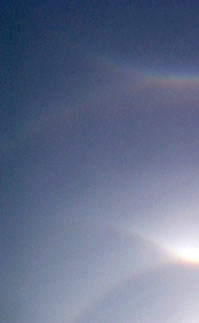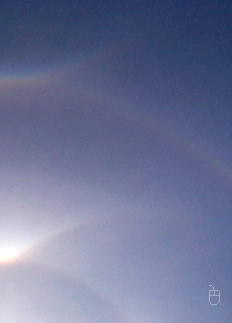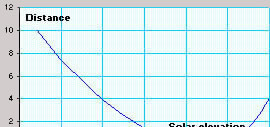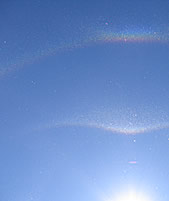
OPOD
What's New
Rays & Shadows
Water Droplets
Rainbows
Ice Halos
Contents
Crystals
Frequent Halos
Infrequent Halos
Why infrequent?
46° Halo
Formation
or supralateral?
Supra/infralateral
Parry Arcs
Lowitz Arcs
Moilanen Arc
Kern Arc
120° Parhelia
44° Parhelia
Subhorizon Arcs
Pyramidal
Multiple Displays
Other Worlds
Observing Halos
HaloSim
High Atmosphere
Links & Resources
Search - Index
123456789012345678
| Is it a 46� halo or a supra/infralateral arc? |
|
The 46° halo is clearly separated from the CZA when
the sun is less than 15° or greater than 27°
high. This can help in distinguishing between 46° and supralateral
arcs. |
|
|
Sun altitude: When the sun is higher than 32° a supralateral arc cannot form . However, a very high sun can produce infralateral and circumhorizon arcs approximately 46° below the sun.
|
|
|
Distance from a circumzenithal arc A supralateral arc always touches a circumzenithal arc. The 46° halo is below the CZA and separated from it when the sun is lower than 15° or higher than 27°. The graph shows the separation between the 46° halo and the CZA. At solar elevations of 15 to 27° it is not possible to tell the 46° halo and supralateral arc apart by this method. |
|||||||||||||
|
|
||||||||||||||||||||
Cusps at parhelic circle Indicate supralateral and infralateral arcs, the two arcs cross at the parhelic circle whereas the 46° halo would cross it without any discontinuity.
|
|
||||||||||||||||||||
Brightness distribution The 46° is uniformly bright around its circle. A supralateral arc is brightest at its top for solar altitudes greater than 15° - but variations in clouds can mislead. |
|||||||||||||||||||||
Colours: A supralateral arc tends to have more saturated (brighter) colours than the 46° halo. The presence of blues and greens are strong indicators that the halo is a supralateral arc. Colours are not definite evidence for one or the other. |
|||||||||||||||||||||










